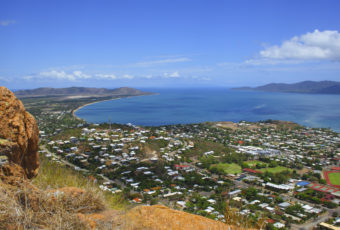Monash scientists study Red Sea as it heads for its ocean destiny
In the only place on the planet where a new ocean plate is still forming, scientists are learning more about the forces that reshape Earth.
The Red Sea is pushing the African and the Arabian continental plates away from each other, and will eventually split these landmasses, which are still joined in the northern Red Sea.
Tectonics specialist Associate Professor Peter Betts from Monash University said there was still little understanding of the origins of new oceans.

“We know how the planet reconfigures itself over time and what happens when ocean and continental plates start colliding,” Associate Professor Betts said.
“That’s when you get earthquakes and volcanoes—on the west coast of the US, the Andes in South America, around Japan and the Pacific Rim. But we don’t understand how new ocean plates, and a new ocean, begin.”
The latest discoveries to emerge from a collaboration between Associate Professor Betts, Monash University colleague Dr Laurent Ailleres and Dr Khalid Almalki (now with the King Abdulaziz City for Science and Technology in Saudi Arabia) have overturned conventional thinking about ocean birthing.
Rather than the single-stage rift theory, which suggests one continuous zipper-like opening of the ocean floor from which new ocean crust is formed, the researchers think a new ocean crust may happen in stages, not through a single “unzipping” event.
They have identified several different volcanic cells beneath the Red Sea, which are becoming active sequentially.
Associate Professor Betts says one cell in the southern Red Sea region has been active for several million years. “However, the increase in seismic activity in the region indicates that a second, more central cell is now awakening,” he says. “In the past 10 years, dyking [magma emplacement] indicates where the new cell is activating.”
This dyking is a build-up of magma that precedes the splitting of the Earth’s mantle to form a new ocean ridge from which the magma will flow to form ocean crust.
Monash School of Earth, Atmosphere and Environment
In July 2014, the new Monash University School of Earth, Atmosphere and Environment was formed, bringing together the former School of Geosciences (Faculty of Science), atmospheric science (School of Mathematics) and physical geography (Faculty of Arts).
It creates a critical mass, an Australian powerhouse of earth sciences education and research.
The innovation is a response to an emerging demand for Monash’s talented teachers and researchers to foster its collaborative ties within its earth sciences sciences. It will build up the foundations of a stimulating, information-rich environment for students, across disciplines.
Monash University‘s reputation in environmental sciences is on an upward trajectory with geography currently ranked number one within the Group of Eight research-intensive universities.
*

































Ask A Question
Ask us about your program of interest, or if you have a question about our services.
CONTACT US TODAY